Related Advancement
- Tenderfoot requirement 1b
- Second class requirement 1a
- First Class requirement 1a
- Camping merit badge requirement 9b6
- Climbing merit badge
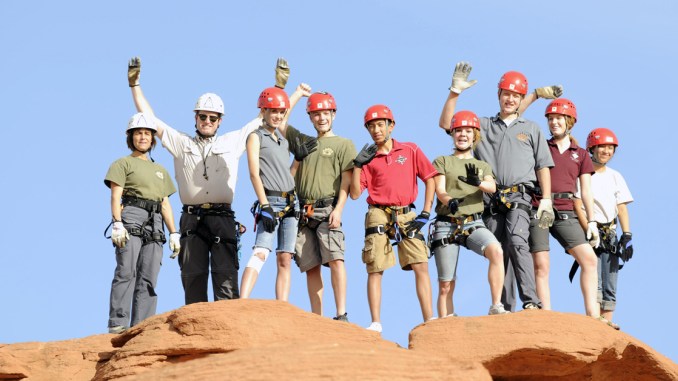
Climb On Safely – Climb On Safely is the Boy Scouts of America’s procedure for organizing BSA climbing and rappelling activities at a natural site or a specially designed facility such as a climbing wall or tower. Climb On Safely includes eight core points. These guidelines are summarized below:
- Qualified Supervision — All climbing and rappelling must be supervised by a mature, conscientious adult at least 21 years of
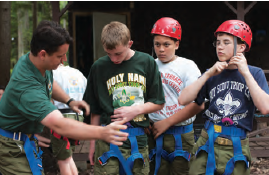 age who understand he risks inherent in these activities. This adult supervisor is trained in and committed to compliance with the eight points of Climb On Safely and is responsible for recruiting trained instructors and verifying their qualifications. One adult supervisor is required for every 10 participants with a minimum of two adults for any one group.
age who understand he risks inherent in these activities. This adult supervisor is trained in and committed to compliance with the eight points of Climb On Safely and is responsible for recruiting trained instructors and verifying their qualifications. One adult supervisor is required for every 10 participants with a minimum of two adults for any one group. - Qualified Instructors – A qualified climbing and rappelling instructor who is at least 21 years of age and trained in the specific type of climbing must supervise all BSA climbing and rappelling activities. There must be a minimum of two instructors for all climbing and rappelling activities (up to 12 participants) and one additional instructor (at least 18 years of age) for up to each additional six participants, maintaining a 6:1 ratio.
- Physical Fitness — Evidence of fitness for the climbing and rappelling activity and a current BSA Annual Health and Medical Record are required. The adult supervisor should adapt all supervision, discipline, and precautions to anticipate any potential risks associated with individual health conditions.
- Safe Area — All BSA climbing and rappelling activities must be conducted using an established climbing and rappelling site or facility. A qualified climbing instructor should survey the site in advance of the activity to identify and evaluate possible hazards and to determine whether the site is suitable for the age, maturity, and skill level of the participants. Each participant and staff member in the fall zone of a climbing and rappelling site must wear a UIAA- or CE-approved rock-climbing helmet. Everyone must be anchored or tethered when within eight feet of a falling hazard.
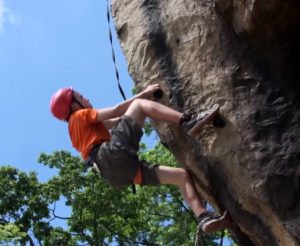 Equipment — The climbing instructor should verify that the proper equipment is available for the size and ability level of the participants. Helmets, harnesses, rope, and climbing hardware must meet appropriate requirements.
Equipment — The climbing instructor should verify that the proper equipment is available for the size and ability level of the participants. Helmets, harnesses, rope, and climbing hardware must meet appropriate requirements.- Planning — Proper planning includes submitting a tour and activity plan, sharing the climbing and rappelling plan and an alternate plan with parents and the unit committee, securing necessary permits or written permission for using private or public lands, enlisting the help of a qualified climbing instructor, and obtaining a current weather report for the area before the group’s departure.
- Environmental Conditions — The instructor, each adult leader, and each participant assume responsibility for monitoring potentially dangerous environmental conditions that may include loose, crumbly rock, poisonous plants, wildlife, and inclement weather.
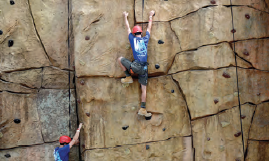 Discipline — Each participant knows, understands, and respects the rules and procedures for safely climbing and rappelling and follows Climb On Safely and Leave No Trace. All participants should respect and follow all instructions and rules of the climbing instructor.
Discipline — Each participant knows, understands, and respects the rules and procedures for safely climbing and rappelling and follows Climb On Safely and Leave No Trace. All participants should respect and follow all instructions and rules of the climbing instructor.
Climb On Safely Training – Climb On Safely training is available in a classroom setting and online. Participants are issued a Climb On Safely card, No. 33774, that is current for two years from the date of training.
Climbing and Rappelling Activity Limitations
Climb On Safely includes the following limits on activities.
Boy Scouts:
- Bouldering no higher than the climber’s shoulder height, with trained spotters
Top-rope climbing with trained belayers - Rappelling with trained belayers
- Belaying with supervision and a backup
Older Boy Scouts:
- Bouldering no higher than the climber’s shoulder height, with trained spotters.
- Top-rope climbing with trained belayers.
- Belaying with supervision.
- Rappelling with trained belayers.
- Top-roped climbing only at the council and district levels.
- Practicing lead climbing with a top-rope belay.
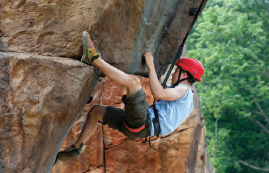 Units with youth who are at least 13 years of age may elect to participate in lead climbing and/or snow and ice climbing only with training from a nationally recognized organization that trains climbing instructors. BSA climbing directors and instructors are not trained in lead climbing or snow and ice climbing.
Units with youth who are at least 13 years of age may elect to participate in lead climbing and/or snow and ice climbing only with training from a nationally recognized organization that trains climbing instructors. BSA climbing directors and instructors are not trained in lead climbing or snow and ice climbing.
Climbing and rappelling facilities may set more restrictive standards than at the local council and district level.
The Week of the Outing – Within the week prior to your main event, it is important to consider these issues:
- Check to be sure that the weather predicted for the place you intend to go is right for what you intend to do; many climbing and rappelling sites do not allow climbing for a certain number of days after it has rained or snowed.
- Check to see that the participants have the necessary equipment and gear for the outing.